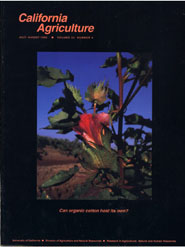All Issues

Can organic cotton hold its own?
Cover:
When this pink flower falls off, the developing cotton boll beneath it will begin to expand. California's organic cotton industry is small but growing, drawing on knowledge developed from integrated pest management (see pages 7,9)... Photo by Zack Griffin ©
July-August 1999
Volume 53, Number 4
Volume 53, Number 4





